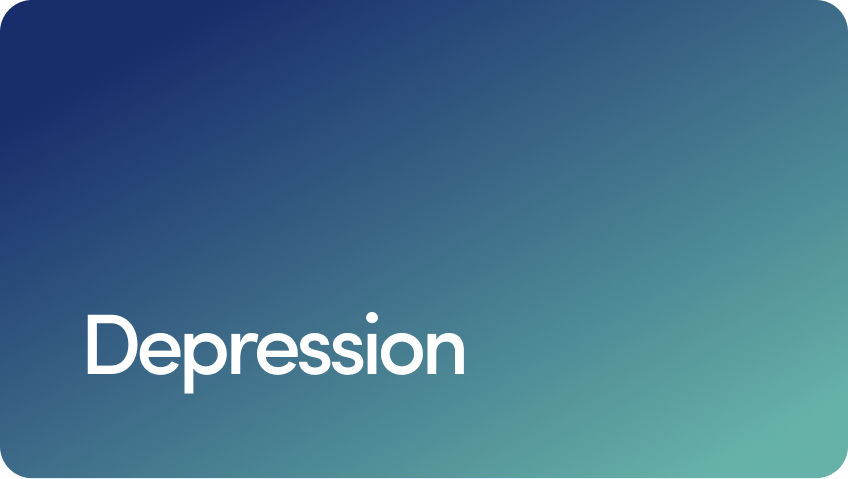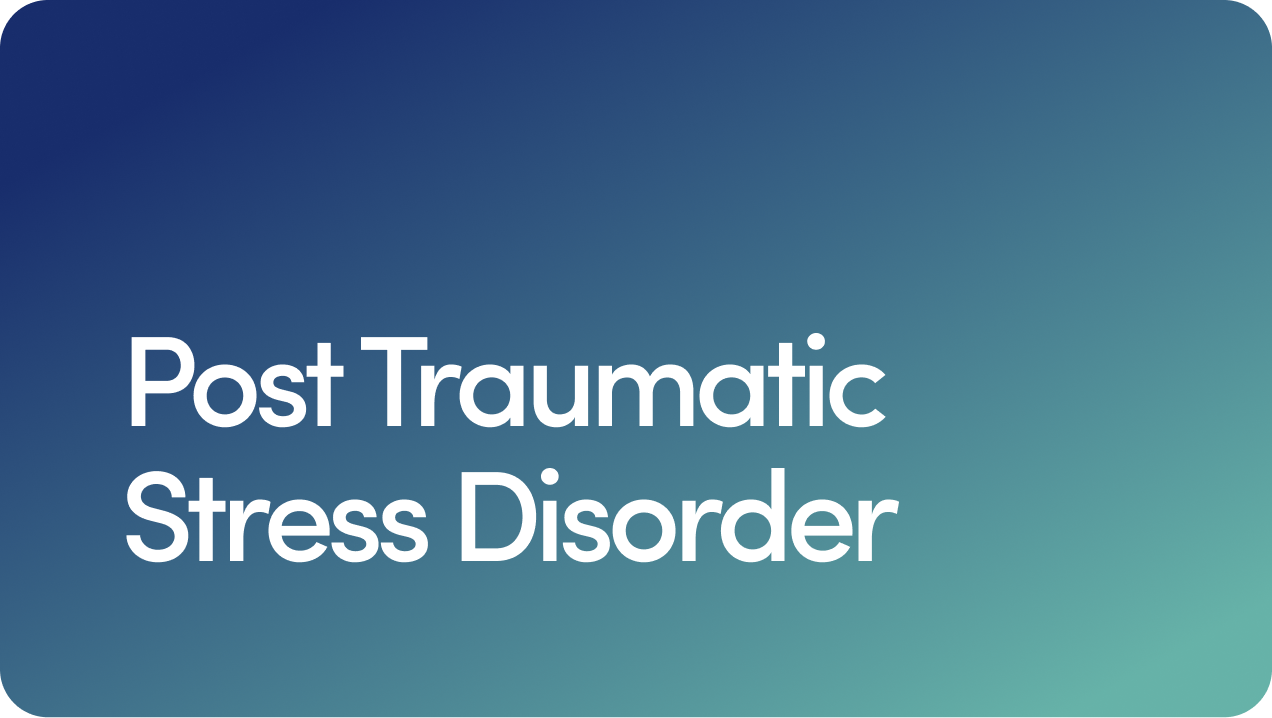Content
Free Mental Health Assessment
Treatments for PTSD: Effective Interventions and Therapies

If you’ve ever experienced a traumatic event, you may struggle with post-traumatic stress disorder (PTSD).
PTSD is a serious mental health condition that requires specialized treatment for effective processing and management.
So, now you may be wondering how to treat PTSD.
Recovery from trauma can be challenging, and because people respond differently to trauma, various types of therapy and medications may help different individuals.
On a more hopeful note, a variety of treatment options have shown to be highly effective, ranging from certain types of therapies to medications and more alternative approaches.
Ahead, we delve into more detail about the best treatments for PTSD and their effectiveness so you can learn more about the options.
Content
What is PTSD?
PTSD, or post-traumatic stress disorder, can develop in individuals who have experienced trauma. In clinical practice, that’s defined as exposure to actual or threatened death, serious injury, or sexual violence. Around 10 percent to 20 percent of people who experience trauma develop PTSD symptoms afterward.
Experiencing a traumatic event can profoundly impact someone’s mental health, as highlighted by the National Alliance on Mental Illness. When the effects of trauma persist long-term, it may manifest as post-traumatic stress disorder.
Examples of traumatic experiences could include:
Sexual assault
A history of child abuse
War
An accident
A natural disaster
About six of every 100 people will experience PTSD at some point in their lives, with women being two to three times more likely to develop it than men.
PTSD Symptoms
Symptoms of PTSD can vary widely depending on the individual and the type of trauma experienced. But there are some common symptoms of PTSD, including:
Avoidance. This symptom involves trying to stay away from situations or people that trigger memories of the traumatic event. You might avoid certain places or even thoughts or feelings related to the incident.
Re-experiencing the trauma. This happens when something reminds you of the trauma, and you feel that fear again. One example is flashbacks or intrusive thoughts that mentally put you back in the traumatic event.
Arousal and reactivity symptoms. You might find yourself constantly being on the lookout for danger to prevent another traumatic event from happening. You could be easily startled, on edge, or have angry outbursts.
Cognition or mood symptoms. These can include harmful changes in thoughts, beliefs, or feelings, such as having negative thoughts about yourself or blaming yourself for the incident.
Major depression is another common problem that can develop after a traumatic event. A review of multiple studies found that major depressive disorder and PTSD are very likely to occur at the same time, with rates ranging from 42 to over 50 percent of patients.
Also, those who’ve had PTSD at some point in their lives are three to five times more likely to develop major depression than those who didn’t experience post-traumatic stress disorder.
Some depressive symptoms can be similar to those of post-traumatic stress disorder, such as trouble sleeping, emotional outbursts, and a loss of interest in activities you used to enjoy.
Post-traumatic stress disorders can also coexist with other anxiety disorders, such as panic disorders, social anxiety, and generalized anxiety disorders.
PTSD Diagnosis
PTSD is typically diagnosed after someone has been experiencing symptoms for more than a month. Specifically, a mental healthcare provider will see whether you’ve had a minimum of the following for at least one month to make a diagnosis:
One avoidance symptom
One re-experiencing symptom
Two mood and cognition symptoms
Two arousal or reactivity symptoms
Symptoms can begin as soon as three months after the traumatic incident or even years afterward.
Treatments for PTSD
There are many different treatment options for post-traumatic stress disorder, including therapies, alternative treatments, and medications for PTSD. Ahead, we’ll cover some of the best ones.
Psychotherapy for PTSD
Various types of therapies are the most common treatments for PTSD. Of these, a few have been proven through evidence-based research to be the best therapy for PTSD and lead to the most post-traumatic growth.
Cognitive-Behavioral Therapy
Cognitive-behavioral therapy (CBT) is a form of psychotherapy that seeks to help people identify unhealthy and negative thought patterns that fuel harmful behaviors and find ways to change them.CBT has consistently been found to be the most effective treatment in both short- and long-term treatment for post-traumatic stress disorder.
Cognitive-behavioral therapy for PTSD focuses on facing and working through the traumatic event gradually. Three types of cognitive-behavioral therapies commonly used in post-traumatic stress disorder treatment are:
Cognitive processing therapy. This therapy focuses on changing maladaptive thoughts and beliefs related to the trauma. Through education, processing the trauma, challenging maladaptive thoughts, and cognitive restructuring, CPT helps individuals reduce PTSD symptoms and improve their overall quality of life.
Prolonged exposure therapy. In exposure therapies, people face their fears by exposing themselves to the source of their trauma. Exposure therapy for PTSD addresses the tendency to adopt unhealthy thinking patterns in the aftermath of a traumatic event. Exposure can happen in the form of recounting a memory, writing about it, or even going to the actual location of the trauma. A randomized clinical trial of 126 adults found that exposure therapies are as effective as cognitive processing therapy.
Stress inoculation training. This is a specific kind of talk therapy developed with PTSD in mind. The goal is to teach people coping skills to help them better manage their symptoms and navigate future stressors.
EMDR Therapy
Eye movement desensitization and reprocessing therapy (EMDR) is a relatively new type of psychotherapy for those struggling with past traumatic events.
EMDR aims to reduce the symptoms of trauma by changing how the traumatic memories are stored in the brain and resolving unprocessed traumatic memories.
In this therapy technique, you perform bilateral stimulation (like taps or eye movement) while focusing on the traumatic memory to reduce the memory's emotional impact. This allows you to heal from the fear and pain associated with the trauma.
One review of research found that EMDR therapy led by a mental health professional can help reduce many symptoms of post-traumatic stress disorder, such as anxiety, depression, fatigue, and paranoid thought patterns.
The World Health Organization has also recommended EMDR for the treatment of posttraumatic stress disorder.
Present-Centered Therapy
Present-centered therapy (PCT) is a type of non-trauma-focused treatment that centers around current issues rather than directly processing the trauma.
Present-centered therapy focuses on increasing adaptive responses to current life stressors and difficulties related to post-traumatic stress disorder symptoms.
This type of therapy teaches people living with post-traumatic stress disorder to understand how symptoms disrupt their day-to-day lives, as well as effective strategies to deal with daily challenges.
Narrative Exposure Therapy
Narrative exposure therapy (NET) is another form of talk PTSD therapy that focuses on helping people create a chronological and coherent narrative, or story, of one’s entire life.
Someone in NET would focus on making sense of traumatic events and be encouraged to include positive life moments in their story.
According to the American Psychological Association, NET is best for those who have experienced multiple traumatic events. It’s also commonly used within group therapy settings for PTSD counseling.
Medications for PTSD
While therapy is one of the best treatment options for post-traumatic stress disorders, healthcare or mental health professionals may also recommend medication.
PTSD medications may also be used to supplement one of the therapies described above.
Selective Serotonin Reuptake Inhibitors (SSRIs)
One of the more common types of medications used is selective serotonin reuptake inhibitors (SSRIs). SSRIs are antidepressants prescribed if a symptom of your post-traumatic stress disorder is a depressed mood.
They work by increasing serotonin — colloquially referred to as the “feel-good” chemical — levels in the brain.
Currently, only two SSRIs are approved by the U.S. Food and Drug Administration for the treatment of PTSD. These are Zoloft® (sertraline) and Paxil® (paroxetine). However, other SSRIs such as Prozac® (fluoxetine), Celexa® (citalopram), and Lexapro® (escitalopram) are sometimes prescribed off-label to treat PTSD.
Serotonin and Norepinephrine Reuptake Inhibitors (SNRIs)
Providers also prescribe selective serotonin-norepinephrine reuptake inhibitors (SNRIs), like Effexor® (venlafaxine) and Cymbalta® (duloxetine), to treat depression and anxiety.
Like SSRIs, SNRIs regulate serotonin. However, they also modify your brain’s levels of norepinephrine, a neurotransmitter and hormone that spikes during stress.
They can be prescribed off-label to treat the anxious and depressive symptoms associated with PTSD.
Alpha-Blockers
Alpha-blockers are a class of drugs that help treat hypertension (high blood pressure). They work by limiting the effects of the hormone norepinephrine so that it doesn’t tighten blood vessels, which can slow or block blood flow.
One example of an alpha blocker is Minipress® (prazosin). Providers sometimes prescribe it off-label to treat the PTSD symptom of recurring nightmares.
More research is needed to understand exactly how alpha-blockers treat PTSD, but initial research shows promise.
Alternative Treatments for PTSD
Emotional Freedom Technique
The emotional freedom technique (EFT or tapping) is an evidence-based treatment that uses acupressure. This method uses physical pressure on specific sensitive points of the skin to relieve pain and muscle tension.
For PTSD, a trained EFT mental health professional will teach you how to tap certain rhythms on your hands, head, face, and collarbones while you actively reframe your memories of a traumatic event.
EFT therapies may decrease your cortisol (stress hormone) levels, and studies have found that these therapies can also reduce symptoms of anxiety disorders and major depression.
Experimental Drug Treatments
Recently, researchers have looked into the effectiveness of ketamine, a non-opioid anesthetic, for some mental health conditions, including depression and PTSD.
While researchers aren’t totally sure how ketamine works for PTSD, they know it blocks N-methyl-D-aspartate (NMDA) receptors in the brain, which play a significant role in memory formation. It also leads to activation of α-amino-3-hydroxy-5-methyl-4-isoxazole propionic acid (AMPA) receptors, which stimulate the growth of healthy brain cells.
Although the FDA has not approved ketamine to treat PTSD, it has been used off-label to manage pain and depression since the 1970s.
There have been few studies on the effectiveness of ketamine in treating PTSD, but one review found that low doses might provide relief for those with long-term PTSD. On the other hand, it also found that ketamine wasn’t effective in individuals with early PTSD or in service members with PTSD.
Another study showed promising findings for ketamine as a treatment for PTSD but emphasized the need for further research into the proper dosing methods, timing, and frequency of use.
Getting Help for PTSD
Regardless of the treatment you choose, seeking professional help of any kind is a step in the right direction. While every path to healing is different, here are a few actions you can take:
Follow your treatment exactly as outlined by a healthcare professional, and avoid self-medicating, whether with alcohol, drugs, or medications not prescribed to you.
Stay informed about PTSD to understand your symptoms and treatment better, including how they impact your life.
Practice self-care, whatever that may look like to you, and show yourself compassion.
Stay connected to people you trust, whether they are loved ones or a support group.
You can also learn more about what to expect during your first therapy appointment.
PTSD Treatments: Key Takeaways
While there isn’t a single best treatment for PTSD, mental health professionals strongly recommend several therapies and medications.
Here’s what to remember when exploring PTSD treatment:
Common symptoms of PTSD include avoidance, re-experiencing the trauma, heightened arousal and reactivity, and changes in cognition or mood.
Cognitive-behavioral therapy is a well-researched treatment for PTSD. Newer PTSD therapies like EMDR and EFT are also available. Regardless of the therapy you choose, make sure you go to a licensed mental health professional experienced with PTSD treatment.
In addition to therapy, medications like SSRIs and SNRIs are both prescribed off-label to help manage some of the symptoms of PTSD.
Some people may need to try different treatments to discover what works best for their PTSD. You can talk to a healthcare provider for recommendations or have a consultation with our online mental health resources to find out if medication might be suitable for you.
For support from trained crisis counselors experienced in trauma-related distress, you can contact the U.S. Department of Veterans Affairs at 1-877-927-8387 or the National Sexual Assault Hotline at 1-800-656-4673, depending on your situation.
23 Sources
- American Psychological Association. (2017). Eye Movement Desensitization and Reprocessing (EMDR) Therapy. Retrieved from https://www.apa.org/ptsd-guideline/treatments/eye-movement-reprocessing
- American Psychological Association. (2017). Medications for PTSD. Retrieved from https://www.apa.org/ptsd-guideline/treatments/medications
- American Psychological Association. (2017). Narrative Exposure Therapy (NET). Retrieved from https://www.apa.org/ptsd-guideline/treatments/narrative-exposure-therapy
- Anxiety & Depression Association of America. (2021). PTSD Treatment & Facts. Retrieved from https://adaa.org/understanding-anxiety/posttraumatic-stress-disorder-ptsd/treatment-facts
- Basquez RY, et al. (2023). Prazosin. Retrieved from https://www.ncbi.nlm.nih.gov/books/NBK555959/
- Belsher BR, et al. (2017). Present‐centered therapy (PCT) for post‐traumatic stress disorder (PTSD) in adults. Retrieved from https://www.ncbi.nlm.nih.gov/pmc/articles/PMC6486094/
- Church DA, et al. (2018). Guidelines for the Treatment of PTSD Using Clinical EFT (Emotional Freedom Techniques). Retrieved from https://www.ncbi.nlm.nih.gov/pmc/articles/PMC6316206/
- Du RU, et al. (2022). The Multivariate Effect of Ketamine on PTSD: Systematic Review and Meta-Analysis. Retrieved from https://www.ncbi.nlm.nih.gov/pmc/articles/PMC8959757/
- Du OR, et al.(2023). Long term structural and functional neural changes following a single infusion of Ketamine in PTSD. Retrieved from https://www.nature.com/articles/s41386-023-01606-3
- Flory JA, et al. (2015). Comorbidity between post-traumatic stress disorder and major depressive disorder: alternative explanations and treatment considerations. Retrieved from https://www.ncbi.nlm.nih.gov/pmc/articles/PMC4518698/
- Jewett BE, et al. Physiology, NMDA Receptor. Retrieved from https://www.ncbi.nlm.nih.gov/books/NBK519495/
- Kung SI, et al. (2012). Treatment of Nightmares With Prazosin: A Systematic Review. Retrieved from https://www.ncbi.nlm.nih.gov/pmc/articles/PMC3538493/
- Molero P, et al. (2018). Antidepressant Efficacy and Tolerability of Ketamine and Esketamine: A Critical Review. Retrieved from https://pubmed.ncbi.nlm.nih.gov/29736744/
- National Alliance on Mental Illness. (2017). Posttraumatic Stress Disorder. Retrieved from https://www.nami.org/About-Mental-Illness/Mental-Health-Conditions/Posttraumatic-Stress-Disorder/
- National Institute of Mental Health. (2024). Post-Traumatic Stress Disorder. Retrieved from https://www.nimh.nih.gov/health/topics/post-traumatic-stress-disorder-ptsd
- Olff MI. (2017). Sex and gender differences in post-traumatic stress disorder: an update. Retrieved from https://www.ncbi.nlm.nih.gov/pmc/articles/PMC5632782/
- Sloan DE, et al. (2018). A Brief Exposure-Based Treatment vs Cognitive Processing Therapy for Posttraumatic Stress Disorder: A Randomized Noninferiority Clinical Trial. Retrieved from https://jamanetwork.com/journals/jamapsychiatry/fullarticle/2669771
- Stahl ST, et al. (2005). SNRIs: their pharmacology, clinical efficacy, and tolerability in comparison with other classes of antidepressants. Retrieved from https://pubmed.ncbi.nlm.nih.gov/16142213/
- Reisman MI. (2016). PTSD Treatment for Veterans: What’s Working, What’s New, and What’s Next. Retrieved from https://www.ncbi.nlm.nih.gov/pmc/articles/PMC5047000/
- U.S. Department of Veterans Affairs. (n.d.). PTSD: National Center for PTSD. Retrieved from https://www.ptsd.va.gov/understand_tx/stress_inoculation_training.asp
- Watkins LA, et al. (2018). Treating PTSD: A Review of Evidence-Based Psychotherapy Interventions. Retrieved from https://www.ncbi.nlm.nih.gov/pmc/articles/PMC6224348/
- Wilson GE, et al. (2018). The Use of Eye-Movement Desensitization Reprocessing (EMDR) Therapy in Treating Post-traumatic Stress Disorder—A Systematic Narrative Review. Retrieved from https://www.ncbi.nlm.nih.gov/pmc/articles/PMC5997931/
- World Health Organization. (2013). WHO releases guidance on mental health care after trauma. Retrieved from https://www.who.int/news/item/06-08-2013-who-releases-guidance-on-mental-health-care-after-trauma
Editorial Standards
Hims & Hers has strict sourcing guidelines to ensure our content is accurate and current. We rely on peer-reviewed studies, academic research institutions, and medical associations. We strive to use primary sources and refrain from using tertiary references. See a mistake? Let us know at [email protected]!
This article is for informational purposes only and does not constitute medical advice. The information contained herein is not a substitute for and should never be relied upon for professional medical advice. Always talk to your doctor about the risks and benefits of any treatment. Learn more about our editorial standards here.
Daniel Z. Lieberman, MD
Education
Doctor of Medicine - New York University Grossman School of Medicine, 1992
Bachelor of Arts - St. John’s College, 1985
Training
Internship & Residency - New York University Grossman School of Medicine, 1996
Medical Licenses
District of Columbia, 1996
Maryland, 2022
Virginia, 2022
Board Certifications
American Board of Psychiatry and Neurology, Psychiatry, 1997
American Board of Psychiatry and Neurology, Addiction Psychiatry, 1998
Other Certificates & Certifications
Stanford Online, AI in Healthcare Specialization Certificate, 2025
Stanford Online, Machine Learning Specialization Certificate, 2024
Affiliations & Memberships
Specialties & Areas of Focus
Mental Health
Years of Experience
33
Previous Work Experience
Professor and Vice Chair - Department of Psychiatry and Behavioral Sciences, George Washington University, 1996–2022
Publications & Research
Title: A neurotransmitter approach to the trolley problem
Published in: OBM Neurobiology
Date: 2019
URL: https://www.lidsen.com/journals/neurobiology/neurobiology-03-02-030
Title: An automated internet application to help patients with bipolar disorder track social rhythm stabilization
Published in: Psychiatric Services
Date: 2011
URL: https://psychiatryonline.org/doi/10.1176/ps.62.11.pss6211_1267
Title: Enhancing adherence to mood charting with an online version of the NIMH Life Chart
Published in: Annals of General Psychiatry
Date: 2010
URL: https://annals-general-psychiatry.biomedcentral.com/articles/10.1186/1744-859X-9-S1-S11
Title: The role of gender in single versus married patients with bipolar disorder
Published in: Comprehensive Psychiatry
Date: 2010
URL: https://www.sciencedirect.com/science/article/abs/pii/S0010440X0900128X
Title: Evaluation of the stability and validity of participant samples recruited over the Internet
Published in: CyberPsychology and Behavior
Date: 2008
Title: Pathways to change: The effect of a Web application on treatment interest
Published in: The American Journal on Addictions
Date: 2008
URL: https://onlinelibrary.wiley.com/doi/10.1080/10550490802138525
Media Mentions & Features
Washington Post, Why do passengers freak out on airplanes? Science might have the answer.
Associated Press, MillerCoors Tapping Into Millenials
The Washington Post, Holiday drinking can be hard on your health, but you can take precautions
Le Figaro (France), Daniel Z. Lieberman: «La dopamine nous pousse à acheter en nous promettant le bonheur» (Daniel Z. Lieberman: “Dopamine drives us to buy by promising us happiness”)
Men’s Health (Spain), Cómo la dopamina influye en nuestro cerebro y determina nuestra vida (How dopamine influences our brain and determines our lives).
CNBC, The psychological reason it’s so hard to work today after the riot — and how to cope
Business Insider, The reason why we self-sabotage is because our brains are wired to resist the things we want most in life
U.S. News & World Report, How Your Secrets Can Damage and Maybe Even Kill You
Why I Practice Medicine
I practice medicine because I believe that mental health is the foundation of a meaningful life. When people suffer psychologically, it touches every part of their existence—from relationships to work to the simple ability to feel joy. Because it can be so difficult for people who are suffering to find good mental health care, my mission has been to expand access through technology, so that no one is left behind.
Hobbies & Interests
I like to write in my spare time. I’ve written two nonfiction titles, Spellbound: Modern Science, Ancient Magic, and the Hidden Potential of the Unconscious Mind and the international bestseller, The Molecule of More: How a Single Chemical in Your Brain Drives Love, Sex, and Creativity--and Will Determine the Fate of the Human Race
Professional Website or Profile
danielzlieberman.com
Related Articles
Related Conditions
 Anxiety
Anxiety
 Depression
Depression
 OCD
OCD
 PTSD
PTSD
 Bipolar Disorder
Bipolar Disorder
 Premenstrual Dysphoric Disorder
Premenstrual Dysphoric Disorder